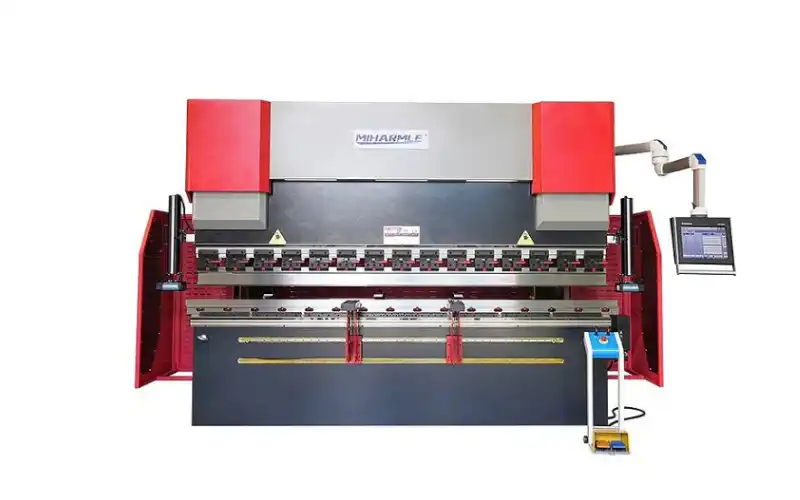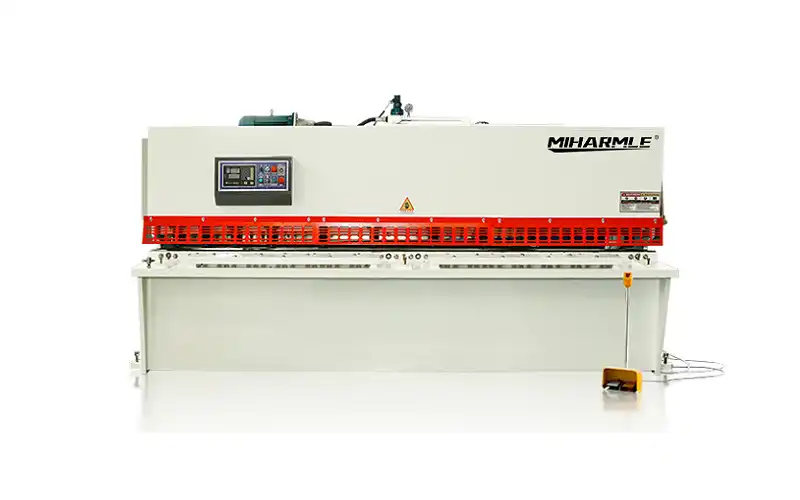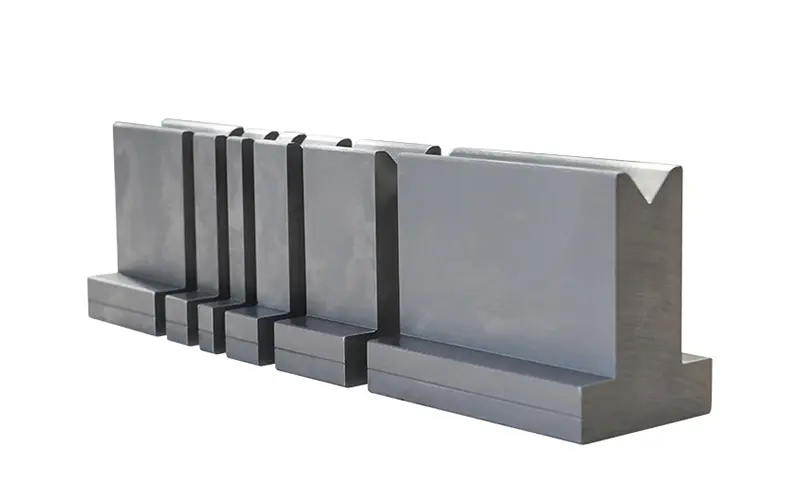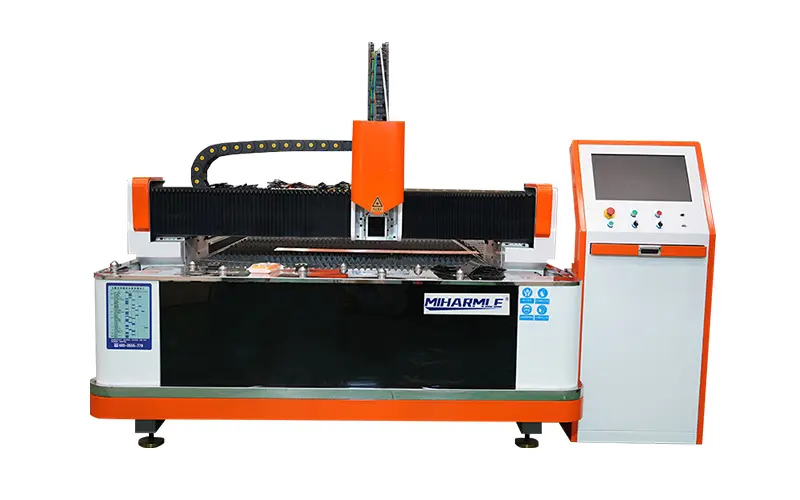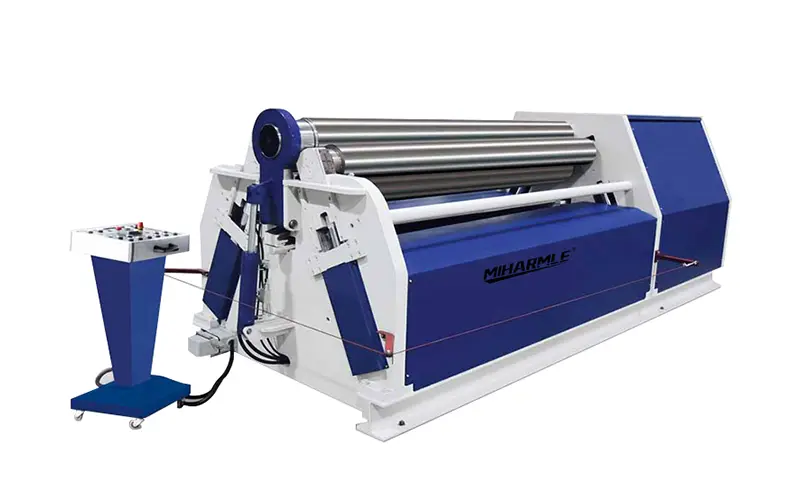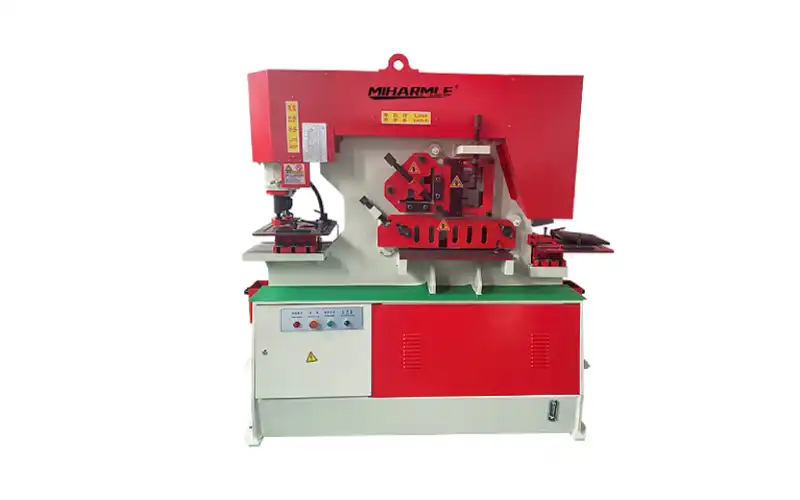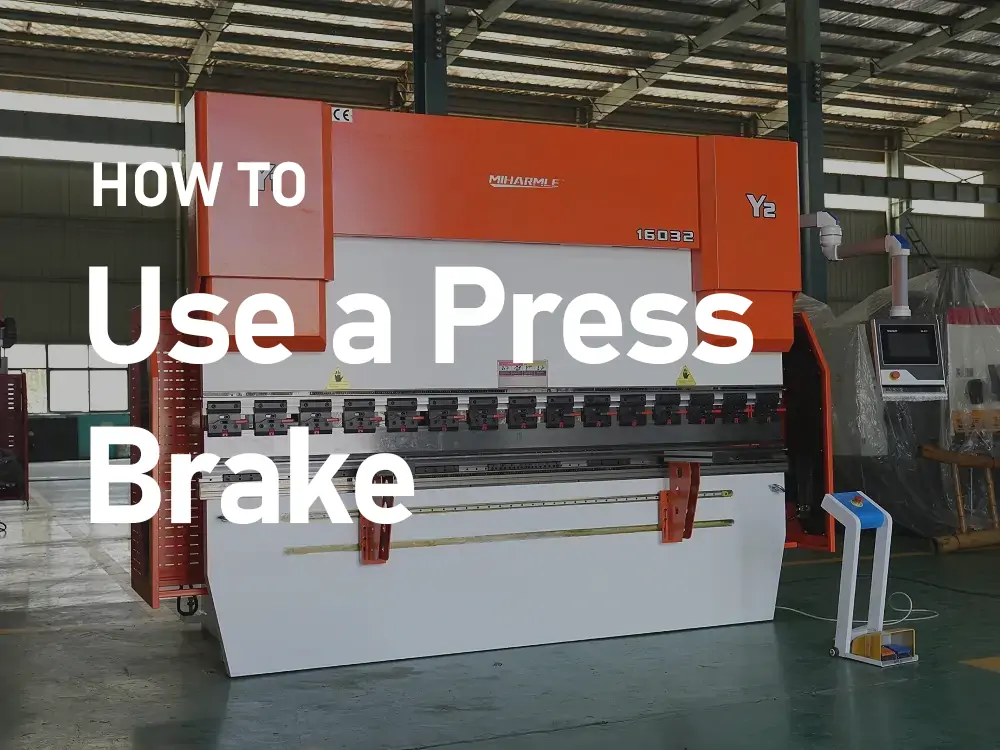Introduction
Press brakes are specialized devices employed in sheet metal forming operations. They are used in the manufacturing sector to shape metal parts. The two main components of a press brake are the ram and bed. For bending, the metal sheet is placed between these two parts. Press brakes can be classified into mechanical press brakes, hydraulic press brakes, electric press brakes, and CNC press brakes.
All press brakes consist of a punch and die combination. These are supported vertically by two C frames. When the ram presses into the bed, the punch bends the metal sheet into the desired shape. Press brakes make the process of forming metal efficient and accurate. In the following sections, you will learn how these machines are operated.
Work Preparation
Several precautions must be taken before operating a press brake. Let us walk you through the work preparation stage step-by-step.
Selecting the Right Die and Punch
Choosing a punch-and-die combination is the very first decision you will make. Tonnage refers to the force required to bend metal. It depends on the material and thickness of the metal sheet. The type of punch and die you choose will determine this tonnage.
Punches, also known as top tools, are available in various modes. Fundamental punches are the Swan Neck Punch, Goose Neck Punch, and Acute Angle Punch.
Dies, or bottom tools, also come in several variants. The unique types are V-shape dies, U-shape dies, multi-V dies, and Z-inserts.
Tool Material and Hardness
Tool material is important because it affects strength, performance, and durability. You will see materials like steel, alloys, carbides, and polymers used for press brake tools. For high-tonnage applications, hardened steel is the ideal choice. If, however, you are working with softer materials, using polymers and low-alloy tool steels can prevent surface tears and ensure proper stretchability.
Tool Coatings
Coatings or surface treatments are applied to tools to maximize tool life and effectiveness. One such treatment is laser hardening, which hardens the contact point of a punch. Similarly, black oxide coatings are applied to make tool material corrosion-resistant. Heat treatment methods like Nitrix prevent galling and increase tool durability. Diamond-like carbon and titanium nitride are also applied to increase strength and cutting ability.
Matching Tools to Material and Thickness
The material and thickness of the workpiece significantly impact the choice of tools. Essentially, these factors determine the tonnage required for bending. Lighter materials like aluminum can be bent easily, whereas heavier metals like steel are harder to bend. Similarly, the thicker the metal sheet, the more tonnage is required.
Suitable Types of Materials to be Bent
In general, modern press brakes are able to bend a variety of metals. The suitability depends on the material’s ductility, which determines how much it can bend without breaking. The most widely used metals in press brakes are mild and stainless steel, aluminum, copper, and brass.
Measuring and Cutting Materials to Size
Preparing press brake operation involves measuring and cutting the workpiece. Depending on the bed length of your press brake, you will be able to work with large or small sheets. Measure the workpiece and remove any sharp edges, burrs, or unnecessary protrusions. The cutting procedure can be done by hand or with specialized tools like laser and plasma cutters. Align the sheet properly in the press brake using the back gauge.
Setting up the Press Brake
Press brake setup involves making a series of preparations. Use the tonnage chart provided by the manufacturer to determine the dimensions of the die. You should select a tool based on the material specifications of the workpiece.
The punch, or the top tool, is fitted to the ram. Similarly, the die, or the bottom tool, is fitted to the bed. Ensure that they are firmly secured. Make sure that alignment is correct. Incorrect alignment can cause damage to the machine.
The back gauge is immensely useful in sequencing multiple bends. Ensure that it is properly aligned. If you are making multiple bends, verify the programming on the CNC console.
Set the appropriate ram stroke to adjust the depth of movement according to the workpiece.
How to Operate a Press Brake
We will now walk you through the procedure for operating a press brake. Let’s assume that we are bending a 10-foot aluminum sheet.
Pre-Operation Inspection
Before inserting the sheet into the press brake, we must inspect the area around us. We should take things slow and analyze the machine, workpiece, and station.
Reviewing the Manual
Go through your machine’s instruction manual. This will help you familiarize yourself with its features, parts, control system, and safety mechanisms.
Inspecting the Machine
Undertake a broad inspection of the press brake. Look out for signs of scars, defects, or spillage. If you are working with a hydraulic press, ensure the cylinders are in perfect condition.
Inspecting the Tools
The machine tools must be in perfect condition. Analyze them for any cracks or undulations. Next, check the fastenings on the ram and bed. Make sure that the tools are securely attached to the press brake. Lastly, ensure that the punch and die combination is appropriate for the workpiece.
Work Area Organization Requirements
The work area should be uncluttered and debris-free. Before operating the press brake, take some time out to clear any stray materials, objects, or equipment that could cause tripping hazards. Ensure that moving parts are lubricated, but avoid over-lubrication.
Setting up the Press Brake
Now that you have performed all the pre-operation inspections, it’s time to set up the press brake. Ensure that you have used compatible tooling. Cross-check the tonnage chart. Align the punch and die on the ram and bed, respectively. Verify the programming of the back gauge if you are performing multiple bending operations. Fine-tune the ram stroke according to your workpiece.
Performing the Bending Operation
Now, it is time to insert the aluminum sheet into the press brake and start the bending process.
- Place the metal sheet between the punch and the die on the bed. Hold it in position either manually or using clamps. Verify that it is in proper alignment with the back gauge.
- To initiate the bend, press down on the foot pedal. If you are using a CNC or electric press, start the process using the computer console. Monitor the bending operation closely.
- Closely observe the entire process to ensure that it is proceeding correctly. Pay attention to any unusual vibrations that could indicate an issue.
- After bending, extract the sheet from the machine and measure it. You can use a physical instrument or an optical device to do this. Make adjustments to the press brake to remove any inaccuracies.
- The computer defines the sequence for multiple bending operations. Follow the instructions displayed on the console, and use the back gauge to execute each bend properly.
Final Inspection and Quality Control
Now that you have completed the press brake operation, it’s time to analyze the workpiece. Does it meet all the required quality standards?
- Turn off the machine using the procedure defined by the machine maker. Before taking further action, make sure that the moving parts have stopped.
- Calculate the angle of the metal sheet using measurement tools like protractors, vernier calipers, or vision machines. The angle must correspond to the dimensional specifications on the design sheet.
- Ensure that the bend is consistent throughout long workpieces. Analyze the workpiece for any signs of roughness, damage, or cracks that might compromise its quality.
- If there is a defect, you might need to re-run the entire operation. Make the necessary corrections to the setup and note down your observations. Having detailed documentation helps avoid similar mistakes.
- Once the task has been accomplished, make sure to tidy up the premises. Remove the rubbish, scrap metal, and equipment from the area and make it safe for walking.
- Conduct routine maintenance of the press brake. Follow the maintenance schedule as outlined by the device manufacturer.
Safety Precautions When Using the Press Brake
Security and well-being are highly important when using press brakes. These powerful machines should not be used lightly. Press brake safety can roughly be divided into operator safety and machine safety. Let’s go over some fundamental measures.
General Safety Measures
Use Personal Protective Equipment (PPE)
Personnel must wear adequate protective clothing while operating the press brake. Protective equipment includes safety glasses, work gloves, steel-reinforced boots, and hearing protection. Press brake operation involves heavy machines, so it is advised not to be in its proximity without safety gear.
Safe Work Environment
The workspace around the press brake should adhere to standardized factory norms. The environment should be well-lit, the floors free of debris or spillage, and fire extinguishers should be present nearby. Safety exits should be highlighted and accessible.
Machine Specific Safety
Pre-Operation Inspection
It is important to examine the machine before bending it. The operator must ensure that its safety features are working perfectly. Look out for any signs of damage to the body and its components.
Emergency Stop Procedures
Each modern press brake comes equipped with emergency protocols. In some cases, the machine may trigger them automatically. The operator must familiarize themselves with how to manually stop the machine when required. Emergency protocols can go a long way in preventing accidents and machine damage.
Maintenance and Troubleshooting
Regular Maintenance
Daily Inspection Procedures
As part of the daily examination, you must keep these checks in mind:
- The press brake’s exterior should be unharmed. Make sure that gas cylinders are free of leakage, fixtures and screws are tight, and the structure of the machine is intact.
- Perform a safety inspection of the press brake. Safety mechanisms like emergency stops, laser barriers, and shields must be in perfect condition.
- In the case of hydraulic press brakes, make sure that liquid levels are sufficient.
- Clean the machine daily. Make sure that dust, shavings, or metal scraps do not accumulate anywhere on its body.
- Apply lubricants to moving parts like ram guides, back gauges, etc.
- Ensure that bolts and fasteners are firmly secured and offer proper movement.
Lubrication and Cleaning Procedures
Manufacturers provide lubrication and cleaning guidelines. Follow these to keep your machine in top condition.
- Stick to the cleaning schedule as outlined in the user manual.
- Use the recommended cleaning solvents to remove grime, oil, rust, or scraps from the machine body.
- Concentrate on areas of high usage like die holders, punches, back gauge slides, and ram guides.
- Service your machine parts pre-emptively to avoid failure. Replace exhaustive machine parts like filters and seals.
Common Problems and Solutions
Solving Material Spring Back
Material spring back is the property of a metal that resists bending by reverting to its original form slightly. It is a frequent problem in metal forming procedures.
Fabricators perform over-bending to solve material spring back. In this method, you bend the metal a little over the desired angle, keeping in mind the spring back. The over-bend angle is calculated by considering the metal’s properties and thickness. It is accomplished locally by performing trial-and-error bends.
Hydraulic System Problems
Press brakes use gas and liquids to generate power. If the hydraulic cylinders are faulty, there may be leakage or pressure imbalances. This may cause performance issues in the machine.
Regularly examine the magnitude of pressure in hydraulic cylinders. They should be within the range specified by the manufacturer. The connection and pipes that transfer hydraulic fluid must be secure and operational. Regularly replace hydraulic liquid within the timeframe mentioned by the manufacturer.
Control System Failures
Control systems in CNC and electric press brakes provide for highly automated operation. However, system crashes and malfunctions can lead to operational failure.
You must ensure that the computer software is up-to-date and functioning properly. Diagnostic tools can help identify problems before they mature. In case of a software crash, seek assistance from qualified professionals.
Alignment Problems
Proper alignment of the punch and die is essential for producing accurate bends. Misalignment may ruin the workpiece and damage the machine.
Never operate the machine without verifying punch and die alignment. Use precision alignment tools. Some press brakes provide laser-assisted alignment systems, but conventional tools like calipers and gauges can also be used.
FAQs
What materials can be bent by a press brake?
Press brakes can bend various metals, such as mild and stainless steel, aluminum, copper, and brass. A material’s suitability depends upon its flexibility and elasticity. It should not be brittle, which can cause cracks during bending.
What kind of bends can be achieved by a press brake?
There are three kinds of bending techniques performed using press brakes, which are:
- Air Bending is the most common type of bending. The punch does not press into the die, leaving some space between the metal sheet and the bottom of the die. Air bending makes a wide range of angles with a limited set of molds.
- Bottom Bending: Bottom bending involves the punch sinking to the bottom of the die. There is no space between the two, and the metal sheet is fully compressed. This method produces highly accurate bends but requires more tonnage than air bending.
- Coining: Derived from the process of making coins, this type of bending requires maximum pressure. It bends and compresses the metal, reducing its thickness by 15-30%. This method produces highly accurate bends while accommodating material springbacks.
How can I minimize errors when using a press brake?
Keep the following things in mind to minimize errors when using press brakes:
- Emphasize the setup. Take extra time if necessary. Proper setup and calibration pay off in the long run and will save you a lot of hassle.
- Try to reuse the press brake settings. Divide your work batches accordingly. Processing similar kinds of products will save you the trouble of frequent orientation.
- Pay attention to material properties and how they affect the tonnage.
- Put some effort into equipment upkeep and service.
How can I troubleshoot a press brake if it is not working properly?
If you can’t figure out what’s wrong with your machine, try these steps:
- Check the power source. Is the machine receiving electricity? Make sure that emergency checks are not engaged.
- Are all the safety features and sensors functioning properly?
- Is the hydraulic state of the machine optimal?
- Is the CNC control panel functioning properly?
- Check the mobile components and the physical frame. Are there any signs of damage?
Choose a MIHARMLE Press Brake
At MIHARMLE, we take pride in manufacturing state-of-the-art machines for businesses like yours. We specialize in producing hydraulic press brakes, shearing machines, power presses, fiber laser cutting machines, etc. Fulfilling our customers’ manufacturing dreams gives us immense joy. With more than 50 export countries, we seek new clients to build a better tomorrow. Are you considering purchasing a press brake? Contact our professional team for a free consultation! We look forward to hearing from you.

